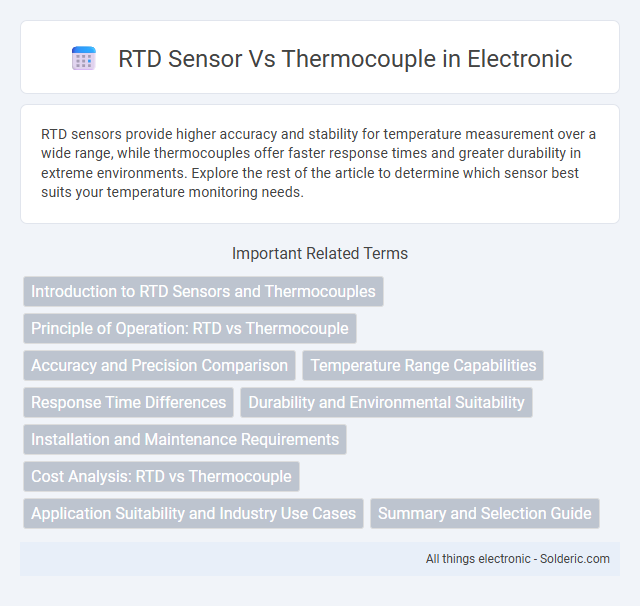RTD sensors provide higher accuracy and stability for temperature measurement over a wide range, while thermocouples offer faster response times and greater durability in extreme environments. Explore the rest of the article to determine which sensor best suits your temperature monitoring needs.
Comparison Table
| Feature | RTD Sensor | Thermocouple |
|---|---|---|
| Temperature Range | -200degC to 850degC | -200degC to 1750degC |
| Accuracy | High (+-0.1degC to +-0.5degC) | Moderate (+-1degC to +-5degC) |
| Response Time | Slower | Faster |
| Durability | Less rugged, sensitive to mechanical shock | More rugged, suitable for harsh environments |
| Signal Type | Resistance | Voltage (millivolt) |
| Cost | Higher | Lower |
| Applications | Laboratory, industrial process control requiring precision | Industrial, automotive, aerospace high-temperature monitoring |
Introduction to RTD Sensors and Thermocouples
RTD sensors and thermocouples are two widely used temperature measurement devices, each with distinct operating principles and applications. RTDs utilize electrical resistance changes in materials like platinum to provide accurate, stable temperature readings over a wide range. Your choice between these sensors depends on factors such as temperature range, accuracy requirements, response time, and environmental conditions.
Principle of Operation: RTD vs Thermocouple
RTD sensors operate on the principle that electrical resistance of a metal, typically platinum, increases predictably with temperature, allowing precise measurement through resistance changes. Thermocouples generate a voltage difference at the junction of two dissimilar metals that varies with temperature, enabling temperature detection by measuring this thermoelectric voltage. RTDs provide higher accuracy and stability in controlled environments, while thermocouples excel in wider temperature ranges and faster response times.
Accuracy and Precision Comparison
RTD sensors offer higher accuracy and better precision than thermocouples due to their stable resistance-temperature relationship and lower susceptibility to electrical noise. While RTDs typically provide accuracy within +-0.1degC to +-0.5degC, thermocouples usually range from +-1degC to +-2degC depending on the type and calibration. RTDs are preferred in applications requiring tight temperature control and repeatability, whereas thermocouples are chosen for wider temperature ranges and faster response times despite lower precision.
Temperature Range Capabilities
RTD sensors typically measure temperatures from -200degC to 850degC, offering high accuracy and stability within this moderate range. Thermocouples can measure much wider temperature ranges, from -270degC up to 2300degC depending on the type, making them suitable for extremely high-temperature environments. Your choice depends on the specific temperature range requirements of your application and the level of precision needed.
Response Time Differences
RTD sensors typically exhibit slower response times ranging from 1 to 10 seconds due to their larger sensing elements and reliance on metal resistance changes. Thermocouples respond much faster, often within milliseconds to a second, because they generate voltage directly from temperature differences without needing thermal equilibrium. This rapid response makes thermocouples ideal for applications requiring real-time temperature monitoring and quick detection of transient changes.
Durability and Environmental Suitability
RTD sensors offer greater durability and stability in harsh environments due to their resistance to corrosion, oxidation, and vibration, making them ideal for long-term use in industrial settings. Thermocouples, while more robust against extreme temperatures and rapid temperature changes, are more susceptible to wire degradation and oxidation over time in corrosive or high-moisture environments. Your choice should consider RTDs for reliable performance in stable, controlled conditions and thermocouples for applications requiring quick response and tolerance to very high temperatures.
Installation and Maintenance Requirements
RTD sensors require careful wiring and protection due to their delicate platinum elements, making installation slightly more complex compared to thermocouples, which are generally more robust and easier to install in harsh environments. Maintenance for RTDs involves periodic calibration and inspection to ensure accuracy, while thermocouples often need less frequent calibration but may require replacement if damaged or degraded by extreme conditions. Both sensor types benefit from proper shielding and grounding to minimize electrical noise, but RTDs demand greater precautions during handling to avoid element breakage.
Cost Analysis: RTD vs Thermocouple
RTD sensors typically incur higher initial costs due to their precise construction and use of platinum elements, making them more expensive than thermocouples. Thermocouples offer cost-efficiency with lower upfront investment and are suitable for applications requiring wide temperature ranges and rugged environments. Maintenance and longevity play a crucial role in total cost analysis, where RTDs provide stable, high-accuracy readings that can reduce calibration frequency, potentially offsetting their higher purchase price over time.
Application Suitability and Industry Use Cases
RTD sensors offer high accuracy and stability, making them ideal for precise temperature measurements in industries like pharmaceuticals, food processing, and aerospace. Thermocouples excel in high-temperature environments and rapid response needs, commonly used in steel manufacturing, power plants, and automotive testing. Your choice depends on the required temperature range, accuracy, and environmental conditions for optimal application performance.
Summary and Selection Guide
RTD sensors offer higher accuracy and stability over a wide temperature range, making them ideal for precise industrial applications, while thermocouples provide faster response times and can measure extremely high temperatures at a lower cost. Selection depends on factors such as temperature range (RTDs up to 850degC, thermocouples up to 1800degC), accuracy requirements (RTDs with +-0.1degC tolerance outperform thermocouples), and environmental conditions including vibration and chemical exposure. Consider RTDs for consistent, long-term monitoring and thermocouples for high-temperature or rapid-change environments where budget constraints exist.
RTD sensor vs thermocouple Infographic

 solderic.com
solderic.com